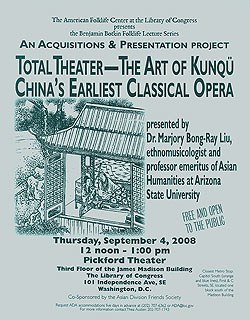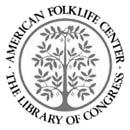| |
|||
|
|
The American Folklife Center at the Library of Congress September 4, 2008 Event Flyer Total Theatre — The Art of Kunqü
|

|
In China, folk dances were part of the early culture, and ritual dance and song can be traced back to the Zhou dynasty (1122-256 B.C.). Later, as dance incorporated a storyline that was sung and acted out, it gradually developed into opera. Chinese opera, especially Kunqü, is particularly noted for its graceful dance movements and gestures that are an integral part of the total art form, unlike many western operas where the aural aspect is predominant
907 A.D.), the Pear Garden, a royal school that trained actors, used dance, song, and dialogue based largely on historical tales. Female roles were played by male actors who sang falsetto in the dramas. In the following Song dynasty (960-1279 A.D.), new poetic forms enlarged and enhanced the repertoire with shi, based on the natural tonal inflections of Chinese speech, and ci, a freer and more colloquial type of tonal poetry. In the Yuan dynasty (1279-1368), in the north, a mixed play (Zaju) format evolved from loosely gathered fouract plays featuring a medley of martial and civil stories using everyday speech and lively vigorous rhythms, emphasized by music played predominantly on string instruments. Meanwhile, in the south, a theatrical form, chuanqi, emerged, in which a play had many acts and scenes, and characters employed refined expressions and polished styles. The plots were mainly based on love stories or romances. This southern Qu song format used fewer words, more vocal ornamentation, slower rhythms, graceful dance movements, and subtle dramatic expression. It was accompanied predominantly by flute and other wind instruments. This, then, was the characteristic style of Kunqü, which was the qu opera originating in the town of Kunshan, near Suzhou and Shanghai in south China.
Kunqü classical opera was perfected in the Ming dynasty (1368-1644 A.D.). It uses four main acting roles, namely: sheng, a young male scholar-hero; dan, a female role; jing, a male warrior-statesman; and chou, a comic. Kunqü demonstrated sophistication in relating total speech to melody patterns, and it integrated the arts of dance, poetry, music, mime, symbolism and drama into a complete aesthetic experience which is still admired and enjoyed today.
Dr. Liu will introduce the concept of qu-pai, or song-tone-patterned verse, which uses a specific pattern of level and undulating speech tones in each line of the lyrical verse. In addition, each verse has a designated number of lines, and each line has its own number of words. Each opera scene consists of several qu-pai linked consecutively in a song-set (lian tao). Also discussed will be the unique Kunqü vocal style, using glottalization to interrupt melismatic passages or to define certain speech tones. This is a very ingenious way of delineating meanings.
In addition, the little-mentioned term wu-tou will be described as a peak moment in Kunqü, where the integration of all audio-visual aspects of the opera results in an aesthetic culmination and overlapping of the senses, much like the effect of synaesthesia. These and other characteristics of Kunqü will be illustrated. Kunqü can truly be described as the consummate total theater, the first truly mature classical opera in China. Although Peking Opera (Jing ju) developed later from the northern qu style, and superseded Kunqü in popularity, it actually adopted many features from Kunqü, especially the latter’s elegant style, and the music of the civil plays. Today, both opera genres continue to be performed, and Kunqü serves as a model for all subsequent Chinese opera forms.
Dr. Marjory Bong-Ray Liu was born in Nanjing, China and spent her first twenty years absorbing both Chinese and Western musics and operas. She later enhanced her studies of Kunqü in Taiwan and mainland China. In 1981, she spent half a year in residence at the prestigious Jiangsu School of Opera in Nanjing, where she was able to observe the daily vigorous training techniques for the young opera students. Since then she has continued to study the complex art of Kunqü.

The American Folklife Center was created by Congress in 1976 and placed at the Library of Congress to "preserve and present American Folklife" through programs of research, documentation, archival preservation, reference service, live performance, exhibition, public programs, and training. The Center includes the American Folklife Center Archive of folk culture, which was established in 1928 and is now one of the largest collections of ethnographic material from the United States and around the world. Please visit our web site.
| ||||
